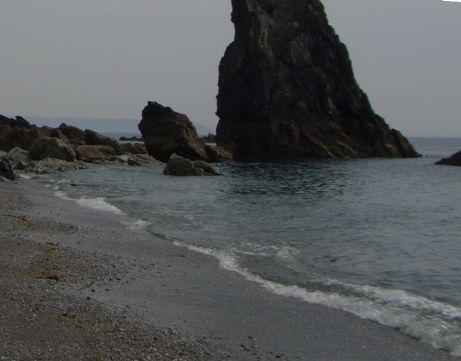Waves
The power of waves is one of the most significant forces of coastal change. Waves are created by frictional drag as the wind blows over the surface of the ocean. We often think of the air as being weightless and 'nothing' but in fact it has real power, as you discover when you try to walk into a gale! The same forces you experience when you walk into the wind are applied to the surface of the sea as the air is moved across it. Friction is created at the boundary between the air and water, pushing water in the direction of the wind. This creates a swell and a wave is created. Energy from the wind begins to rotate the water, turning it in a forward moving circle. In this way the wave can move forward and will continue doing so until it either reaches an obstacle, like land, or it runs out of energy, eg: the wind stops.
The two main factors that determine the size and power of a wave are the strength
of the wind and the distance over which it blows. A strong wind blowing over
hundreds of miles of ocean will create a more powerful wave than a weak wind
blowing for just a few miles. The uninterrupted distance over which the wind
can blow is called the fetch.
Waves are classified into two groups: destructive or constructive.
Destructive waves are more powerful and cause erosion, whereas constructive waves are less violent and encourage deposition.
Destructive waves are formed by strong winds
with large fetch areas. These waves have high energy levels that have been
built up by travelling long distances and being exposed to strong winds. When
they reach land they tend to break strongly and remove material from the shoreline.
The swash is not as strong as the backwash so the overall effect is to erode
beach material. You will see destructive waves if you visit the coast during
or shortly after a storm. The swash of the wave tends to push material up the
shore and the backwash tends to wash it back again. If there are a lot of waves
they catch up with eachother on the beach and the backwash of one wave will
tend to meet the swash of the next wave. This will limit the motion of the
water up the beach and pull some material back out to sea. Less material
will be pushed up the beach. The backwash will be the most powerful process
and there will be a net loss of material from the beach. Typically between
11 and 15 destructive waves will break every minute.
Constructive waves predominate in calmer weather
conditions when less energy is being transfered to the water. They are less
powerful than destructive waves and don't break as violently. Constructive
waves will sometimes not seem to break atall but just run up the beach losing
energy as they do so. The swash is more powerful than the backwash, so more
material is carried up the beach than
is pulled back down it. This leads to an increase in beach sediments. If there
are not many waves each wave will be able to complete both its swash
and backwash without interference from the next wave coming up the beach. Sediment
that has been pushed up the beach by the swash will be deposited up shore,
and the backwash will drain away into the sand. When the next wave breaks its
swash will deposit more material without it being 'captured' by the backwash
of the preceding wave. Typically,
between 6 and 9 constructive waves will break every minute.
Swash: When a wave breaks and the water travels up the beach this is called the swash. Swash pushes sediment up the beach away from the sea.
Backwash: When the water from the waves starts to run back down the beach it is called the backwash. Backwash pulls beach material towards the sea.
Click here to watch a short video clip of backwash disrupting swash. (1.4MB avi format)
Remember...
CONSTRUCTIVE - swash is stronger than the backwash - DEPOSITION
DESTRUCTIVE - backwash is stronger than the swash - EROSION
Destructive waves are associated with stormy conditions and occur where there is a long fetch and strong winds. The waves in the picture were breaking at a frequency of 14 per minute, each swash being interrupted by the powerful backwash of the previous wave. |
|
When a destructive wave hits a cliff the water can hit the rock face with the same sort of force as driving a car into a brick wall at 30mph. The same power that can smash ships to pieces against the rocks is constantly eroding the cliff face. Tiny pockets of air, trapped in the cracks and hollows of the cliff's surface, undergo immense compression as the waves hit , forcing the air into the rock surface and creating 'mini explosions' that weaken the rock. |
|
 d d |
Constructive waves are associated with calm weather. These waves were hardly breaking at all, but it was clear that small particles were being pushed up the beach. Some lateral movement was also taking place (longshore drift) , material being moved from the background to the foreground. The frequency of these waves was 6 per minute. |
![]()
